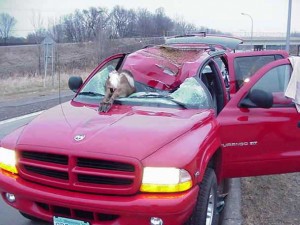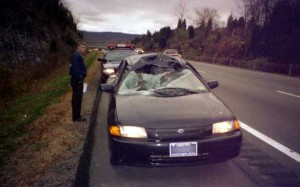 If you were the only kid who didn’t cry when Bambi’s mother was shot, there’s a good chance you now work in auto insurance.
If you were the only kid who didn’t cry when Bambi’s mother was shot, there’s a good chance you now work in auto insurance.
The reason being, of course, the $3.8 Billion dollars worth of deer-related auto insurance claims made last year, and the 140 human deaths that resulted from them – just the latest addition to the staggering cost that these animals rack up year after year.
We all feel sorry for deer that have been killed on the road, but the truth is that many motorists are in danger from hitting them on dark roads at night, and feel that there are not enough controls and barriers in place to prevent accidents. One begins to wonder whether the cost of insurance claims made as a result of deer accidents is higher than the cost of fencing highways in high-risk areas.
Allan Sloan, Senior Editor at CNN Money, lives in a semi-rural town where deer often venture into the suburbs. Here these animals grow just so large that, when hit by a regular passenger car, the bulk of the animal goes through the windshield, often killing or seriously injuring the passengers.
Hitting a deer at high speed is very often fatal, and is almost certainly a life-changing event. The deer also carry ticks, which can spread Lyme disease – something which costs the health insurance industry millions of dollars each year. He says:
“The total goes over $4 billion when we throw in the cost of accidents in which no claims were made because drivers had no comprehensive insurance on their vehicles, or no insurance at all. The costs combine State Farm’s [Insurance] estimate of an average $3,103 per claim paid by insurers with the estimated deductible, $250, absorbed by drivers.”
The most interesting statistic is that in the past five years there has been a dramatic increase in claims that resulted from deer-related accidents.
There has been an increase of only 2% in average driving miles, which means one of two things, Sloan says: “It means either that drivers have gotten a lot worse at avoiding deer, which seems unlikely, or that a lot more deer are on the roads than there used to be, which seems extremely likely.”
Avoiding Our Furry Friends
If you live in an area where there are deer, or are travelling to one, Sloan says that there are a number of precautions you can take to reduce the chances of hitting a deer. He warns drivers to be especially vigilant from 6 to 9 pm, as this is when deer often are most active.
Remember that deer travel in herds, and that there will probably be more around the corner. Lastly, don’t rely on car-mounted deer whistles, as these are not always effective.






